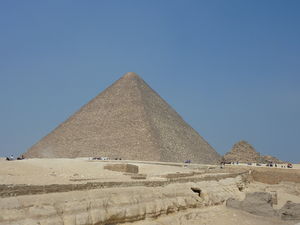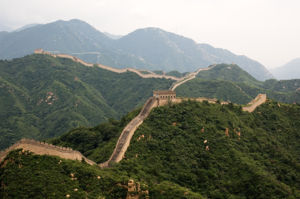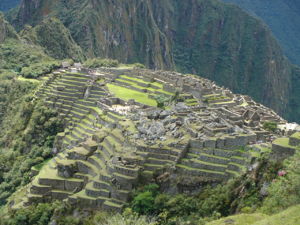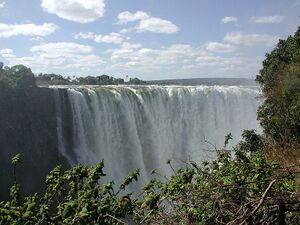Wonders of the world
Various lists of the Wonders of the World have been compiled throughout history. The most well known are the Seven Wonders of the Ancient World. These lists have been compiled over the ages to catalogue and to categorize the most spectacular man-made constructions and natural phenomena in the world. The number seven was chosen because the Greeks believed it to be the representation of perfection and plenty, and later was usually retained in analogy to conform with this ancient practice.
Seven Wonders of the Ancient World
- Main Article:Seven Wonders of the Ancient World
The historian Herodotus (484 BC–ca. 425 BC), and the scholar Callimachus of Cyrene (ca 305–240 BC) at the Museum of Alexandria, made early lists of Seven wonders but their writings have not survived, except as references. The seven wonders included:
- Great Pyramid of Giza
- Hanging Gardens of Babylon
- Statue of Zeus at Olympia
- Temple of Artemis at Ephesus
- Mausoleum of Maussollos at Halicarnassus
- Colossus of Rhodes
- Lighthouse of Alexandria
The earliest lists had the Ishtar Gate as the seventh wonder of the world instead of the Lighthouse of Alexandria.
The Greek category was not Wonders but "thaumata" (Greek: Θαύματα), which translates closer to "miracles". The list that we know today was compiled in the Middle Ages—by which time many of the sites were no longer in existence. Today, the only ancient world wonder that still exists is the Great Pyramid of Giza.
Wonders of the Medieval World
- Main Article:Wonders of the Medieval World
Many lists of wonders of the world are said to have existed during the Middle Ages, although it is unlikely that these lists originated at that time because the word medieval was not even invented until the Enlightenment-era, and the concept of a Middle Age did not become popular until the 16th century.
These lists typically include:
- Stonehenge
- Colosseum
- Catacombs of Kom el Shoqafa
- Great Wall of China
- Porcelain Tower of Nanjing
- Hagia Sophia
- Leaning Tower of Pisa
Wonders of the Modern World
- Main Article:Wonders of the Modern World
The American Society of Civil Engineers compiled a list of wonders of the modern world:
- Channel Tunnel
- CN Tower
- Empire State Building
- Golden Gate Bridge
- Itaipu Dam
- Delta Works/Zuiderzee Works
- Panama Canal
New Seven Wonders of the World
- Main Article:New Seven Wonders of the World
In 2001 an initiative was started by the Swiss corporation New7Wonders Foundation to choose the New Seven Wonders of the World from a selection of 200 existing monuments for profit.[11] Twenty-one finalists were announced January 1, 2006. Egypt was not happy with the fact that the only original wonder would have to compete with the likes of the Statue of Liberty, the Sydney Opera House, and other landmarks; and called the project absurd. To solve this, Giza was named an honorary Candidate. The results were announced on July 7, 2007 in Benfica's stadium in a big ceremony in Lisbon, Portugal, and are listed here:
- Great Wall of China
- Petra
- Christ the Redeemer
- Machu Picchu
- Chichen Itza
- Roman Colosseum
- Taj Mahal
- Great Pyramid of Giza
Seven Natural Wonders of the World
- Main Article:Seven Natural Wonders of the World
Similar to the other lists of wonders, there is no consensus on a list of seven natural wonders of the world, as there has been debate over how large the list should be. One of the many lists was compiled by CNN:
- Grand Canyon
- Great Barrier Reef
- Harbour of Rio de Janeiro
- Mount Everest
- Aurora
- Parícutin volcano
- Victoria Falls
New7Wonders of Nature is a contemporary effort to create a list of seven natural wonders chosen by people through a global poll, organized by New Open World Corporation (NOWC), which ran the New Seven Wonders of the World campaign.
Seven Wonders of the Underwater World
- Main Article:Seven Wonders of the Underwater World
The Seven Underwater Wonders of the World was a list drawn up by CEDAM International, an American-based non-profit group for divers, dedicated to ocean preservation and research.
In 1989 CEDAM brought together a panel of marine scientists, including Dr. Eugenie Clark, to pick underwater areas which they considered to be worthy of protection. The results were announced at The National Aquarium in Washington DC by actor Lloyd Bridges.
- Palau
- Belize Barrier Reef
- Great Barrier Reef
- Deep Sea Vents
- Galápagos Islands
- Lake Baikal
- Northern Red Sea
Seven Wonders of the Industrial World
- Main Article:Seven Wonders of the Industrial World
British author Deborah Cadbury wrote Seven Wonders of the Industrial World, a book telling the stories of seven great feats of engineering of the nineteenth and early twentieth centuries. In 2003 the BBC made a seven-part documentary series on the book, with each episode dramatising the construction one of the wonders. The seven industrial wonders are:






